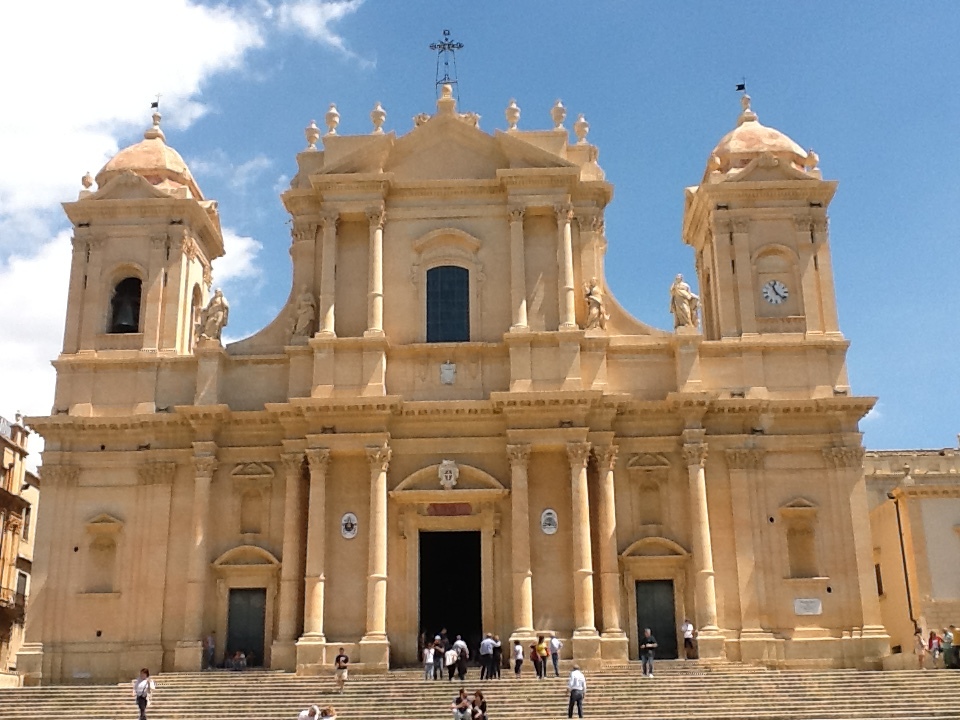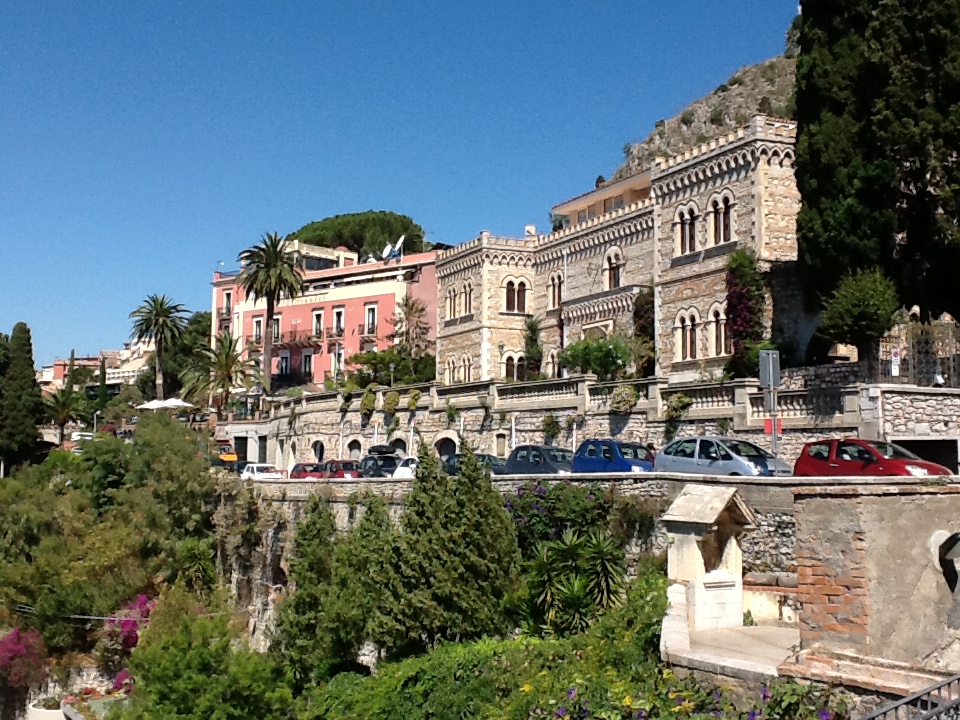This week Rodney Ouzts, friend and fellow travel enthusiast, contributes another of his occasional posts about his Italian travels. Rodney's a natural at this--he paints such a vivid picture that every destination becomes a 'must see'. Today is no exception. Rodney reports on not one but several towns of Southern Sicily, each one more inviting than the last--as you will see for yourself!
Going for Baroque: A Sojourn in Sicily
When flying into the small airport of Comiso in southern Sicily, the first thing you spot before landing are miles and miles of greenhouses reaching almost to the sea. Very quickly, it is apparent you are in one of the top agricultural regions of Italy. Upon landing and driving out of the airport, it seems in those greenhouses are millions of tomato plants. Driving further, you pass acres and acres of orange trees, almond trees and cactuses, some as large as a Fiat 500. The landscape is constantly changing. One minute you feel you are in Provence with white rocky terrains. A few minutes later, you are in North Africa with its arid flat plains. The sea is as clear and clean as any Caribbean island. Then suddenly, the car takes a mountain curve and heads into a green valley.
Sicily is a unlike any other place in Italy. It surprises, seduces, charms and contradicts all you thought you knew about Italy. For me, it is a nice change to the picture perfect rolling hills of Tuscany, the sophistication of Milan, the chaos of Rome or the impossible beauty of Venice. The people we met in restaurants, shops, hotels and even in the streets, are extremely polite, hospitable and seemingly happy you are there.
Sicily is large, in fact, the largest region in Italy at 9,923 square miles with over 5 million inhabitants. The region includes the smaller islands surrounding it including the Aeolian and Egadi Islands, Pantelleria, among others.
The areas where we traveled first are considered Southern and Southwestern Sicily which contains some of the finest and best preserved baroque structures on the island. The archeological sites are legendary including the Greek Theater Syracuse (“Siracusa” in modern Italian) and the Villa del Casale in Piazza Armerina which contains exquisite Roman mosaics discovered fairly recently. Within a few hours drive is the famous Valle dei Templi, containing magnificent remains of a Greek colony. In other words, the island is rich in ancient remains and its history can be traced back 2000 years. It has been dominated by the Greeks, Romans, Byzantines, Arabs, Normans and the Spanish. Scholars and art historians can spend a life time tracing its rich history. This mix of cultures and traditions are what make Sicily so interesting. You are in Italy but you are in a place that is singular, cut off from the mainland of Europe and holding onto all of these outside influences and cultures who at one time or another ruled the island.
We based the first part of the trip in Ragusa, an ancient city divided into two parts: the newer “Baroque Ragusa” built in 1693 after an earthquake; and Ibla, the ancient part of the city inhabited since the 3rd millennium BC. Ibla is built higher up on a rocky crest. One thing to remember is that climbing steps is part of the Sicilian experience so bring comfortable walking shoes. Only Italian women can maneuver safely in their Ferragamo and Prada high heels on these sidewalks. Indeed, I thought I was in better shape until I started climbing cascades of steps at every turn.
Ragusa is not only an excellent town to base oneself in for exploring the region but it is also a perfectly sized town not overrun with tourists. You can settle in and feel a part of this city. We were there during the celebration of their patron saint, San Giorgio. Sitting at a café in the square with the locals that evening, we listened to town’s marching band while enjoying a glass of prosecco and later, like everyone else, followed the statue of the patron saint up the cathedral steps.
Ragusa has wonderful hotel options and excellent food. The local restaurants are quite sophisticated. The chefs in restaurants, we visited respected tradition but took chances. One evening in a small restaurant, my pasta entrée was a traditional “vongole” with baby clams but this chef took it a step further, adding pesto, pistachios and almonds. It may sound a little strange but it was delicious and represented perfectly a mix of the traditions of Italy with the rich varied culture of Sicily.
Not far from Ragusa is the ancient town of Modica, known for its chocolate and the 250 step flight which descends from its Duomo, San Giorgio. Modica is also built on a hill and divided into Modica Alta and Modica Basso. Did I mention there are more steps to climb? It is a bit more touristy due to this reputation for chocolate and ceramics but it is still a good example of a very livable, walkable and pleasing town. In fact, one of the most pleasant surprises of Sicily is wandering around is just as enriching as visiting a museum. The landscapes and architecture never fail to please.
Perhaps one of the best reasons to visit this area, is a visit to Noto. After a devastating earthquake in 1693, the town was rebuilt in the 18th century by such prominent architects as Rosario Gagliardi, Vincenzo Sinatra and Antonio Mazza. It is a planned city and once again, this is not the baroque style one is accustomed to seeing in Germany or Austria. It is more restrained and the first thing you notice about the buildings is the color. Builders used a fragile rose colored stone called “pietra calcarea.” It is very pleasing to the eye and lessens the power of the ornamentation.
Another city worth your time is the Piazza Armerina located in the southwestern region of Sicily. It is known for the 3rd – 4th century AD estate, Villa del Casale. It was the home of a wealthy landowner and contains exceptional mosaics. Like Pompeii, its preservation is due to a natural disaster. In the mid 12th century, a flood caused the rooms of the villa to be buried in mud, thus preserving them. The villa was discovered in the 19th century and the 1950’s and 1960’s, archeologists discovered the mosaics which many consider to be the “most exceptional Roman mosaics in the world.” The site is well organized. You cross the villa on platforms allowing viewers to look down into the rooms. Protecting the site is a roof which protects the mosaics from harm and the visitors from the sun. The details and subject matter of the mosaics are astounding and include chariot races, bathing beauties doing calisthenics, great hunts and much more.
After leaving southern Sicily, we traveled north to the Taormina, one of the best known cities in Sicily. Perched on a cliff above the Ionian Sea, it reminds you of Capri. It has been on the “tourist map” since the days of the Grand Tour. It was especially popular with the British and became known as a refuge for artists, aristocrats, movie stars and the very wealthy. Greta Garbo installed herself for months at a time in one of the villas, renting out the entire place to herself. Other visitors include Henry Moore, Tennessee Williams, Picasso and various Rothschilds. The best known site is the Greek Theatre which sits on the side of the hill with a spectacular view of the sea and Mount Etna. When we were there, they had just hosted Duran Duran the night before. It is a tribute to the builders to witness an ancient site still in use today and just as accommodating as It was 2000 years ago! Like Capri, Taormina is a place to wander, do some shopping, take advantage of the beach, sit in a garden and enjoy some of the wonderful food and wine of the region. It can be overcrowded when the cruise ships dock and bring in their passengers, but the evenings are quieter and beautiful. Taormina is the right place to end a journey in Sicily. After days of steps, sites and scenery, it is restful, light and fun. It reminds you of why you came to visit this magical island and to ask yourself, when can you will return? After all, we did not even make it to Palermo!
Rodney Ouzts and his spouse and partner for life, Massimo, reside in Greensboro, North Carolina and spend as much time as they can in Italy.



















